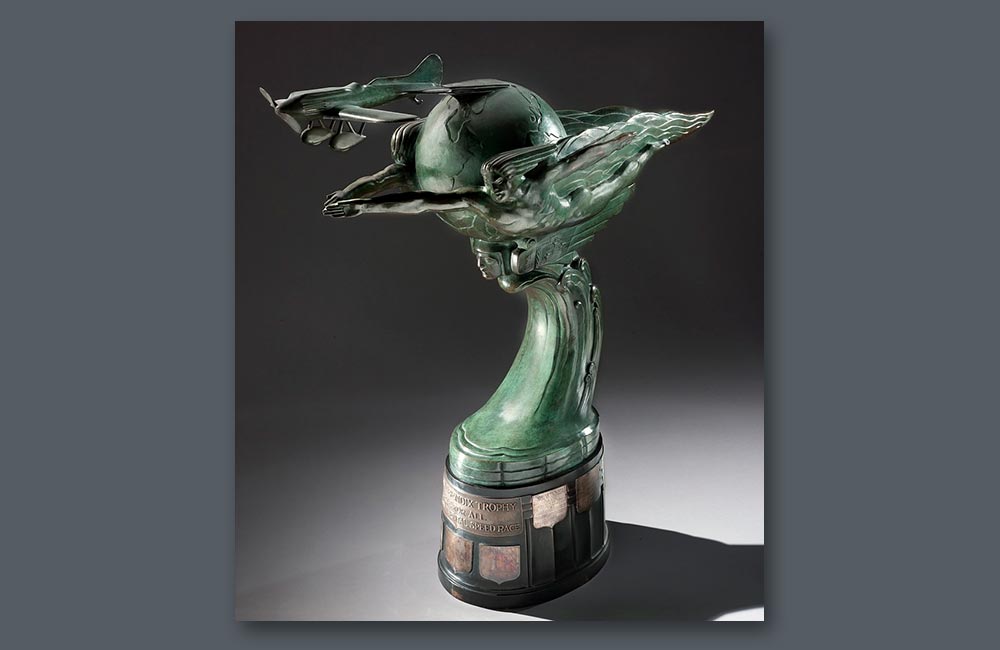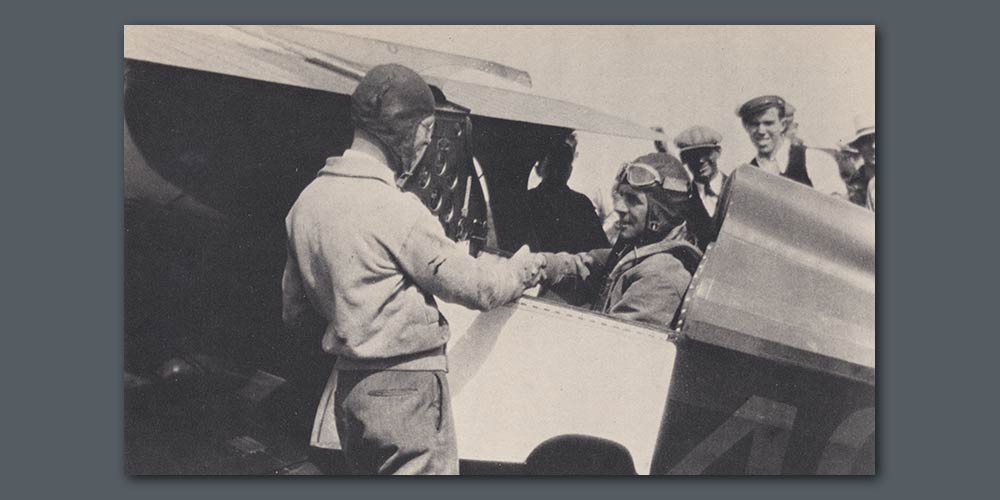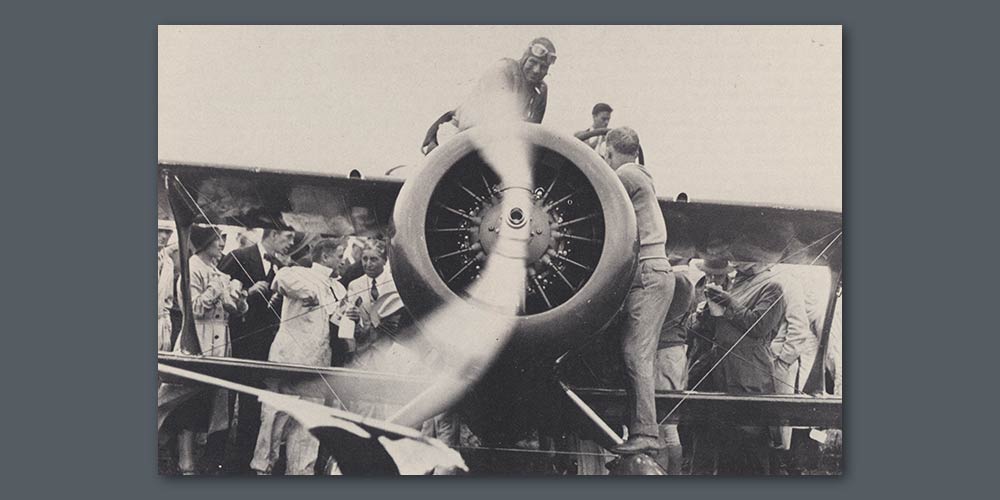

Vincent Bendix, pioneer in the aviation and automotive industries, inventor of international prominence, and President of the Bendix Aviation Corp., sponsored the Bendix Trophy Race with a view to encouraging transcontinental air travel. The race was an open competition from Burbank, California, to Cleveland, Ohio, and stimulated developments in all-weather flying, communications, and navigation. There had been transcontinental air races in 1929 and 1930 under sponsorship of the National Air Race Association, but these were mere sporting events offering little or no prize money. The Bendix suddenly made it lucrative with a purse of $17,750 plus a gold replica of the Bendix Trophy, second, $3,750 with a silver trophy replica, third, $2,500 with a bronze replica, fourth, $1,500 and fifth, $750. An additional $2,500 would go to the pilot who on the same day completed the flight from Cleveland eastward to Newark to establish a true transcontinental speed record.
It was no surprise when eight entries showed up for the running of the first Bendix race on September 4, 1931. Flood lights rimmed the ramp and hangar area at Burbank's Union Air Terminal as the racers were groomed to start. Of the eight racers, six were Lockheed's (three Altairs, two Orions, and one Vega); the remaining two were custom built. One was a modified Travel Air "Mystery Ship," NR614K, which had won the 1929 Thompson Cup Race and the other was Laird's "Super Solution". The 1930 "Solution" was also entered but a landing mishap en-route to the west coast prevented it from making the starting deadline. The contrast between the large Lockheeds, slower but capable of making the distance non-stop and which had dominated the earlier two cross-country races, against the two special speedsters which were just a bit more than flying engine but must refuel along the way, led to vociferous pros and cons as to which would get to Cleveland first.
It seemed as though a million stars were sparkling with excitement in the unusually clear night sky at the drama about to unfold below. Departure was timed so that arrival at Cleveland would occur at the climax of afternoon activities, and as race time approached the tempo of action increased. Large numbers of spectators began to line runway 15, and by 1:00 a.m. all pilots were in their planes with last-minute weather conditions, navigation procedures and flight plans double-checked. Tension ran high ... the Bendix was big business. It shared national headlines with Sir Hubert Wilkins, who was probing under Arctic ice packs with his submarine, the Nautilus.
It was time. Lou Reichers swung his Altair onto the runway, eased the throttle forward and at 1:20 a.m. PST, Larry Therkelsen, official NAA starter, dropped the flag. Fifteen minutes later Walter Hunter responded to the starting flag and eased his 600 hp special Travel Air "Mystery Ship" into the star-studded sky. Harold Johnson bounded down the runway just three minutes later, lifting his new Continental Airlines Orion aloft, followed within five minutes by Asa Chandler's Orion which was piloted by Beeler Blevens. Doolittle would be next. The rest of the contestants would follow within the next twenty minutes.

Jimmy snapped the cockpit shut, checked the latches, pored over the glowing instruments, tightened the seat belt and pulled out to the starting position. The big engine cowl hid his view of the runway; "she was a blind airplane all right but I got used to it" was Doolittle's comment. The starter's flag raised as the Wasp beat out a symphony of power. At 1:40 a.m. PST (4:40 EST) the flag dropped and Jim pushed the throttle to the firewall. The "Super Solution" was airborne in less than 500 feet. Doolittle climbed at a fast rate, skimming the mountains to the east and heading for a brief levelling off at 5,000 feet to check engine temperature gauges. He soon spotted the tail light of Blevens' heavily laden Orion slowly climbing at full throttle. The "Super Solution" zipped past, prompting Blevens to relate later, in his slow Southern drawl, that he figured he was flying backwards or was about to stall out when he saw Jimmy pass. Now Doolittle pointed the Wasp for 11,000 feet and better winds.
Setting a course of 075 degrees, he trimmed the racer, streaked over the Mojave desert and headed straight for Albuquerque, New Mexico. Flagstaff, Arizona passed below and the Laird was dipped into a long whistling shallow dive, planning to arrive at pattern altitude simultaneously with reaching his first fuel stop. Some of the six non-stop starters would no doubt be up at 15 or 16,000 feet taking advantage of the thinner air and stronger tail winds. Every degree of error in navigation, every change of altitude meant minutes to each contestant. For Doolittle, every mile at top speed counted and refueling stops had to be fast.
Albuquerque appeared in the distance and Jim increased his dive. Over the field he peeled into a short pattern and in just 3 hrs. 2 min. after take-off the Laird's wheels touched the ground. He had averaged 228 mph on the first 674-mile leg. Doolittle slid out of the cockpit, wiped his hands on his clean white knickers, swallowed a glass of milk, and slipped back into the pit as the fuel caps were secured. Refreshed and with a full load of fuel the ''Super Solution'' was again nosed toward Cleveland. Dawn was just breaking as Jimmy leveled off at 10.000 feet and sped toward mid western prairies and Kansas City, his next stop.

Unknown to Doolittle at the time, he had gained a commanding lead, since the Lockheeds, still with heavy fuel loads didn't have their running shoes on as yet. Wait Hunter had landed his $15.000 modified Travel Air at Winslow, Arizona, fighting mechanical problems plus a painful ear block caused by a bad head cold. Three hours, six minutes and 765 miles later Doolittle greased the ''Super Solution" onto Kansas City's airport. He only had time to stand in the cockpit and stretch. Refueling was completed and Jim was off again in ten minutes.
By now the sun was high and hot, the air was choppy, and thick cumulus were building. Early afternoon thunder storms appeared, and soon it was apparent a vicious squall line stood like a stone wall guarding Cleveland. To go around or over the storms was impossible, so Jimmy was forced to go on instruments and bore straight through. With his eyes glued to the needle-ball and airspeed, and a glance at the engine instruments, he barrelled into the fire-filled sky. Some of the other pilots were using the new aural null radio direction finder, a bit primitive and subject to static, it effectively forced time-consuming detours around the storms. After a half hour of wild bouncing Jim thankfully noticed the pounding rain was tapering off, and the "Super Solution" suddenly broke into clear sunshine. Dead ahead was the big red and white chequered home pylon with the name Bendix emblazoned on it. Doolittle had sliced through the black turbulence with less than 2 degrees error in navigation.
As he taxied the mud covered ship to the line, Jim spotted his wife, Jo, and their two children, Jim Jr. and John. Jo was waving a lunch she had prepared but Jimmy had already clambered onto the cockpit edge, grabbed a hose and begun assisting in refuelling with more Shell gasoline. He had decided to continue to Newark and attempt the full transcontinental route. The public address system was blaring his name, asking him to come to the speaker's stand, but Jim's winning smile and those characteristic movements of eagerness meant only one thing-he was impatient to be off. With knickers now thoroughly oil soaked, Jim slipped back into the pit, fired up the Wasp and threw sheets of muddy water as his salute to the Cleveland crowd.

Once again the "Super Solution" was airborne and soon was flashing over the infamous Hell Stretch of Allegheny Mountains where the lives of many pioneer airmail pilots were lost. The air was extremely turbulent but Jim had complete faith in the Laird/Wasp combination. Still uncertain if he had won the Bendix, he streaked into Nebraska at 3:51 p.m. His elapsed time from Burbank was 11 hrs. 16 min. 10 sec., his average speed 217 mph, beating the 2,882 mile transcontinental record set by Frank Hawks in his "Mystery Ship" earlier the same year by one hour, eight minutes.
Newsmen and jubilant spectators met the plane as it rolled to a stop. Jimmy was quickly informed that he had indeed won the Bendix and had also set a new transcontinental record-and, incidentally, nice to know, he was $10,000 richer. After spending 30 minutes with the press he climbed back into the trusty "Super Solution" and headed back to Cleveland where he was greeted with a big kiss fiom his wife, and that beautiful prize money. Doolittle then relaxed in the Company's Bellanca executive plane while Jimmy Haizlip flew him to a Victory party in St. Louis. The "Super Solution" was left with Laird and P & W maintenance men to be readied for the Thompson race.
